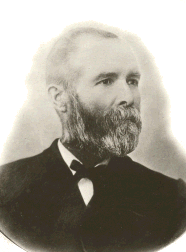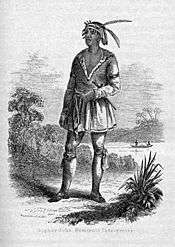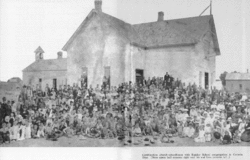American immigration to Mexico
| Total population | |
|---|---|
|
876,528 American nationals residing in the country (2015)[1] Unknown number of Mexicans of American descent | |
| Languages | |
| Mexican Spanish • American English | |
| Religion | |
| Roman Catholicism • Protestantism • Mormonism | |
| Related ethnic groups | |
| Americans and American diaspora |
American Mexicans (Spanish: estadounidense-mexicanos) are Mexican citizens who are either born in, or descended from migrants from the United States and its territories. This can include people of non-Hispanic European, African American, Native American, Asian American, Pacific Islander or Hispanic (of any race) backgrounds.
Americans are a significant demographic in Mexico. Over 75% of immigrants to Mexico are estimated to come from the United States, and Mexico hosts the largest number of US emigrants. Many of the members of the American Mexican community have dual nationality, and among them are entrepreneurs, businessmen, sports professionals, entertainers, artists, religious ministers, academics, and students, among others.
History
.jpg)

The first American settlement in Mexico was the entry of Americans, mostly of European descent, as traders into the country. Including the northern territories of Alta California, Santa Fe de Nuevo México, and Mexican Texas. The first empresarial grant in Texas had been made under Spanish control to Stephen F. Austin, whose settlers, known as the Old Three Hundred, settled along the Brazos River in 1822. The grant was later ratified by the Mexican government. Twenty-three other empresarios brought settlers to the state, the majority from the United States of America. In 1824, Mexico enacted the General Colonization Law, which enabled all heads of household, regardless of race or immigrant status, to claim land in Mexico. Due to the large amount of American settlers, in 1830 President Bustamante outlawed the immigration of United States citizens to Texas, nonetheless immigration continued illegally.
Mexico once recognized citizens born in the territory lost in the Treaty of Guadalupe-Hidalgo to protect their property, farms, and ranches. However, they had to adopt a new nationality and very few descendants had ever decided to regain their Mexican nationality.

Facing the threat of enslavement, in 1850 the Black Seminole leader John Horse and about 180 Black Seminoles staged a mass escape to northern Mexico, where slavery had been abolished more than twenty years earlier. There is a band of the Kickapoo tribe present in northern Mexico as result of 19th-century migration. There is also a Cherokee Nation of Mexico that claims to be the descendents of 19th-century Cherokee migrants. However, they are not officially recognized by the Federal government.
A few of the routes of the Underground Railroad led to Mexico.[2]
In 1865 a substantial number of former Confederates fled to Mexico from the defeated Confederate States of America.[3][4][5] They set up the New Virginia Colony. However, many of the ex-Confederates left the country once Emperor Maxmilian I was overthrown.
One known Mexican of U.S. ancestry is former president Vicente Fox, whose great-grandfather, reportedly of German American ancestry, left Cincinnati for Mexico in the 1860s after the U.S. Civil War.

During the Porfiriato, foreign businessmen were welcomed into the country in order to help with Mexico's modernization through enterprises such as railroad construction and mineral exploitation. American capitalists included the likes of Edward L. Doheny and William Cornell Greene. Also notable among these early entrepreneurs were the Californian immigrants Walter and Frank Sanborn, who opened Mexico's first soda fountain. Their business would go on to become the Grupo Sanborns. Founded in 1888, the American School Foundation in Mexico City was created to cater to American immigrants.
For decades, Mexico has also drawn numerous artists, including Pablo O'Higgins, William Spratling and Waldeen Falkenstein.
During the Cold War, Mexico was a country of refuge for political leftists, and received various American exiles, especially from the film industry. Notable among these individuals was Elizabeth Catlett, prominent African-American artist who was declared an "undesirable alien" by the U.S. government as a result of suspected Communist affiliations.
Recent migrants can be categorized into three broad categories: retired expatriates (which tend to congregate in American colonies like Ajijic or San Miguel de Allende), professionals working in Mexico (tending to reside in large cities like Monterrey or Mexico City) and the American children of Mexican nationals (which can be found throughout the country). Most commonly, these American-born minors follow their parents once they are deported to Mexico. Nonetheless, it is also common for adult children to return to their parents home country of their own will.
Culture
American Mexicans retain customs such as Thanksgiving Day and the Independence Day of the United States celebrated on July 4.[6]

American football arrived to Mexico in 1927, by direct influence of the United States.[7] It started to be played in Mexico City among young students from universities, and sport clubs showing a great interest for this foreign sport of considerable popularity among American students. Throughout the years, the sport became popular at an amateur level among universities of Mexico.[7] The sport has remained popular as a result of easier access to televised MLB and NFL games and the desire of American Mexicans to partake in American pastimes.
Recent migrants, especially those in the retired community, remain closely attached to and promote the values of the U.S. through organizations such as Democrats and Republicans Abroad, the American Legion, and the Sons and Daughters of the American Revolution.[8] Also common among this group is the lobbying of local governments on a range of issues such as development, security, sanitation and historical preservation.[8] This may be problematic if they are not naturalized citizens, since the Mexican Constitution prohibits the involvement of foreigners in the country's politics.[8]
Language
Most Mexicans of American descent speak American English and Mexican Spanish, either of which can be that person's first language. However, not all in the community are proficient in both languages. Among migrants it is not uncommon to find individuals lacking proficiency in Spanish even after years of living in the country.[8] This can be attributed to the relative isolation of American enclaves and the willingness of Mexicans whom they interact with to adjust to English requirements.[8]
Religion
Most Mexicans of American descent are Christians, either Catholic, Protestant, or Latter-day Saints (also known as "Mormons").

According to the 2010 census, 314,932 individuals reported belonging to the Latter-day Saints Church.[9] However the majority of Latter-day Saints in Mexico are ethnic Mexicans. Many Mexican Mormons of American descent reside in the Mormon colonies in Mexico, where some American Mormons settled in the late 19th century. Some of these American Mexicans or their descendants have returned to the United States since, including church leader Marion G. Romney, politician George W. Romney, and chemist Henry Eyring. More recent prominent Mexican Mormons of American descent include Carl B. Pratt, the current president of the LDS Church's Missionary Training Center in Mexico City and a former General Authority of the church.[10] The current president of the LDS Church's Mexico Area, Daniel L. Johnson is also a Mexican of American descent, although his two counselors are both ethnic Mexicans.[11]
There has been a small migration of American Jews into Mexico.[12] A minority may have Mexican Jewish ancestry descended from the Crypto-Jewish population of what is now the Southwest U.S.
Education
There are the following American international schools in Mexico:
Mexico City:
Other cities:
- American School Foundation of Guadalajara
- American School Foundation of Monterrey
- Colegio Americano de Puebla
- John F. Kennedy School, The American School of Querétaro
- Colegio Americano de Torreón
See also
References
- ↑ "Table 16: Total migrant stock at mid-year by origin and by major area, region, country or area of destination, 2015". United Nations, Department of Economic and Social Affairs, Population Division. Retrieved 20 March 2016.
- ↑ "Aboard the Underground Railroad". National Park Service. Retrieved 2 April 2015.
- ↑ Todd W. Wahlstrom, The Southern Exodus to Mexico: Migration Across the Borderlands After the American Civil War (U of Nebraska Press, 2015).
- ↑ Rachel St. John, "The Unpredictable America of William Gwin: Expansion, Secession, and the Unstable Borders of Nineteenth-Century North America." The Journal of the Civil War Era 6.1 (2016): 56-84. online
- ↑ George D. Harmon, "Confederate Migration to Mexico." The Hispanic American Historical Review 17#4 (1937): 458-487. in JSTOR
- ↑ Retiring Americans, Go south, old man by The Economist
- 1 2 GABRIELA DEYANIRA MARTINEZ GARCIA (2007). "AMERICAN FOOTBALL IN MEXICO: FACTORS INFLUENCING SUCCESS OF TEAMS WITHIN THE NATIONAL COLLEGE FOOTBALL ORGANIZATION, ORGANIZACION NACIONAL ESTUDIANTIL DE FUTBOL AMERICANO (ONEFA)" (PDF). tamu.edu. Retrieved 10 December 2014.
- 1 2 3 4 5 Sheila Croucher (2010). The Other Side of the Fence: American Migrants in Mexico. University of Texas Press. pp. 2,3. ISBN 9780292782389.
- ↑ "Panorama de las religiones en México 2010" (PDF) (in Spanish). INEGI. p. 3. Retrieved 2 April 2015.
- ↑ "Newsroom: News Story – Mexico MTC Opens to Train Hundreds of Missionaries", MormonNewsroom.org, LDS Church, June 26, 2013
- ↑ Church News, May 15, 2013
- ↑ Elazar, Daniel J. "Mexican Jewry: Some Persistent Issues". World Zionist Organization. Retrieved 4 January 2016.
External links
- Los que llegaron - Estadounidenses from Canal Once (In Spanish)
